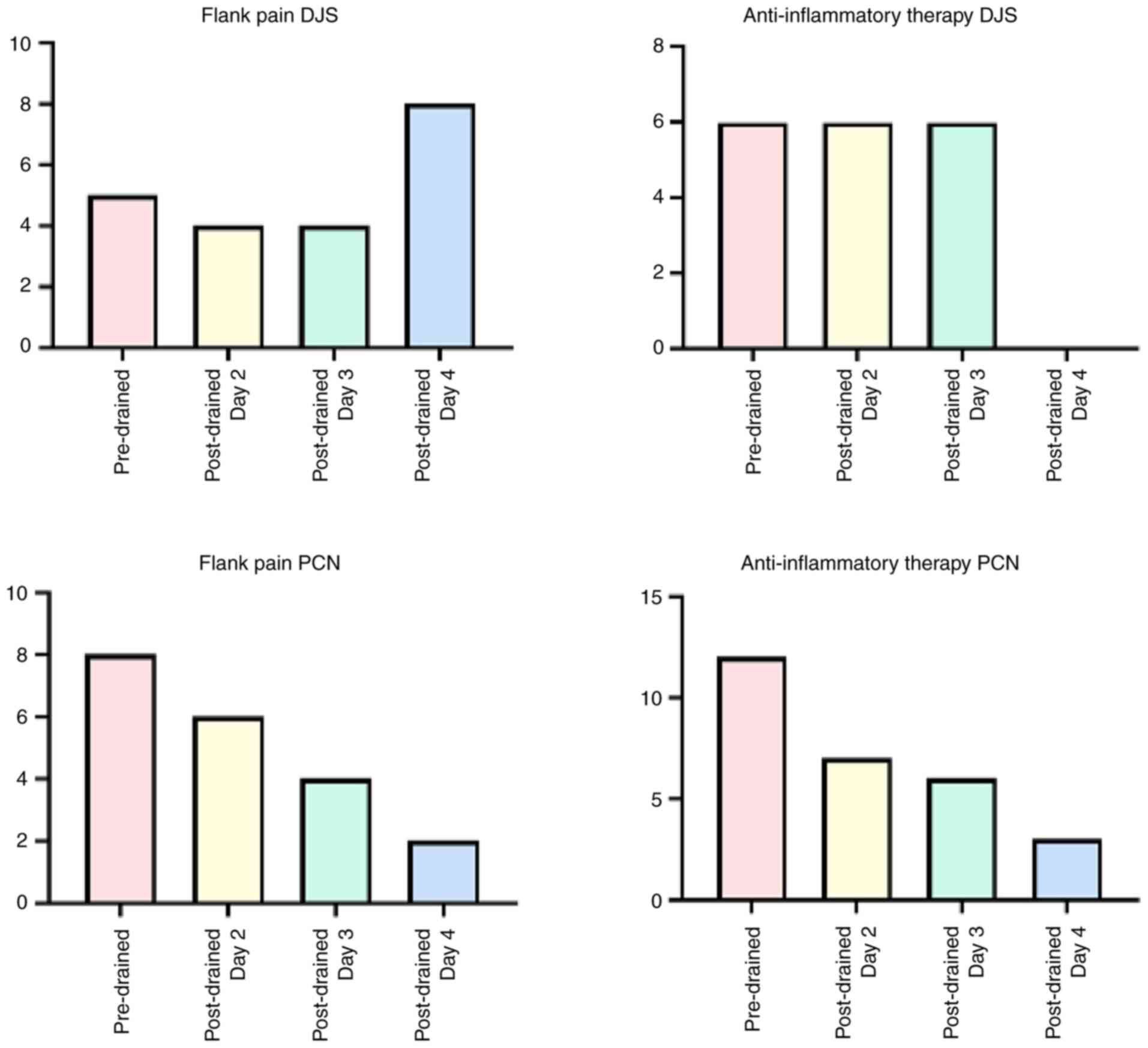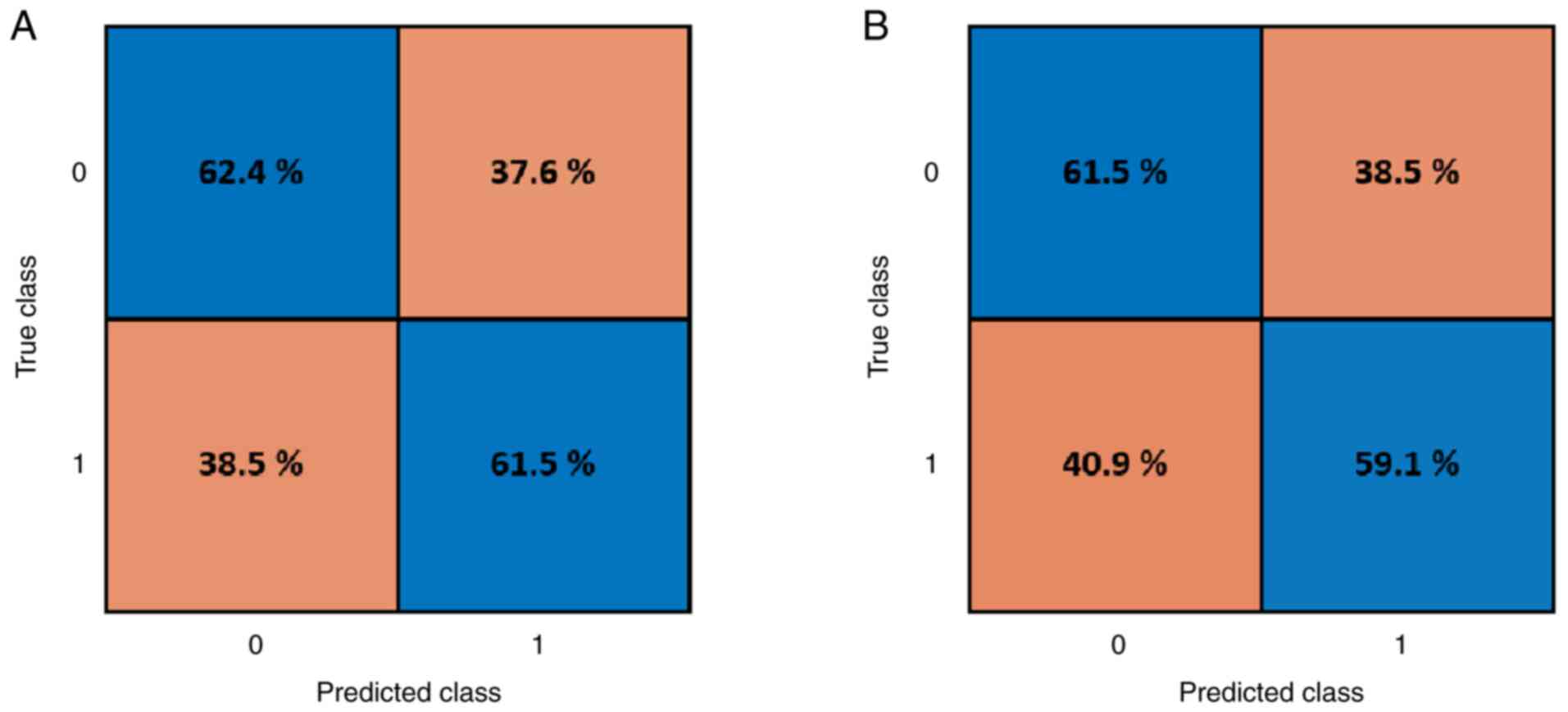|
1
|
Tabib C, Nethala D, Kozel Z and Okeke Z:
Management and treatment options when facing malignant ureteral
obstruction. Int J Urol. 27:591–598. 2020.PubMed/NCBI View Article : Google Scholar
|
|
2
|
Yoon JH, Park S, Park S, Park S, Moon KH,
Cheon SH and Kwon T: Renal function is associated with prognosis in
stent-change therapy for malignant ureteral obstruction. Investig
Clin Urol. 59:376–382. 2018.PubMed/NCBI View Article : Google Scholar
|
|
3
|
Netsch C, Becker B and Gross AJ:
Management of ureteral obstruction: Value of percutaneous
nephrostomy and ureteral stents. Urologe A. 55:1497–1510.
2016.PubMed/NCBI View Article : Google Scholar : (In German).
|
|
4
|
Hardie EM and Kyles AE: Management of
ureteral obstruction. Vet Clin North Am Small Anim Pract.
34:989–1010. 2004.PubMed/NCBI View Article : Google Scholar
|
|
5
|
Clavien PA, Sanabria JR and Strasberg SM:
Proposed classification of complications of surgery with examples
of utility in cholecystectomy. Surgery. 111:518–526.
1992.PubMed/NCBI
|
|
6
|
Zhang Z, Wang X, Chen D, Peng N, Chen J,
Wang Q, Yang M and Zhang Y: Minimally invasive management of acute
ureteral obstruction and severe infection caused by upper urinary
tract calculi. J Xray Sci Technol. 28:125–135. 2020.PubMed/NCBI View Article : Google Scholar
|
|
7
|
Kumar A, Mynderse L, Patel K, Grudem M,
Bakkum-Gamez J, Longenbach S, Block MS, Pitot HC, Garovic V, Weroha
SJ and Jatoi A: Ureteral obstruction in cancer patients: A
qualitative study. Psychooncology. 25:605–609. 2016.PubMed/NCBI View
Article : Google Scholar
|
|
8
|
Joshi HB, Adams S, Obadeyi OO and Rao PN:
Nephrostomy tube or ‘JJ’ ureteric stent in ureteric obstruction:
Assessment of patient perspectives using quality-of-life survey and
utility analysis. Eur Urol. 39:695–701. 2001.PubMed/NCBI View Article : Google Scholar
|
|
9
|
Mokhmalji H, Braun PM, Martinez Portillo
FJ, Siegsmund M, Alken P and Köhrmann KU: Percutaneous nephrostomy
versus ureteral stents for diversion of hydronephrosis caused by
stones: A prospective, randomized clinical trial. J Urol.
165:1088–1092. 2001.PubMed/NCBI
|
|
10
|
de Sousa Morais N, Pereira JP, Mota P,
Carvalho-Dias E, Torres JN and Lima E: Percutaneous nephrostomy vs
ureteral stent for hydronephrosis secondary to ureteric calculi:
Impact on spontaneous stone passage and health-related quality of
life-a prospective study. Urolithiasis. 47:567–573. 2019.PubMed/NCBI View Article : Google Scholar
|
|
11
|
Pearle MS, Pierce HL, Miller GL, Summa JA,
Mutz JM, Petty BA, Roehrborn CG, Kryger JV and Nakada SY: Optimal
method of urgent decompression of the collecting system for
obstruction and infection due to ureteral calculi. J Urol.
160:1260–1264. 1998.PubMed/NCBI
|
|
12
|
Goldsmith ZG, Oredein-McCoy O, Gerber L,
Bañez LL, Sopko DR, Miller MJ, Preminger GM and Lipkin ME: Emergent
ureteric stent vs percutaneous nephrostomy for obstructive
urolithiasis with sepsis: Patterns of use and outcomes from a
15-year experience. BJU Int. 112:E122–E128. 2013.PubMed/NCBI View Article : Google Scholar
|
|
13
|
Hsu L, Li H, Pucheril D, Hansen M,
Littleton R, Peabody J and Sammon J: Use of percutaneous
nephrostomy and ureteral stenting in management of ureteral
obstruction. World J Nephrol. 5:172–181. 2016.PubMed/NCBI View Article : Google Scholar
|
|
14
|
Loughlin KR and Bailey RB Jr: Internal
ureteral stents for conservative management of ureteral calculi
during pregnancy. N Engl J Med. 315:1647–1679. 1986.PubMed/NCBI View Article : Google Scholar
|
|
15
|
Ramsey S, Robertson A, Ablett MJ, Meddings
RN, Hollins GW and Little B: Evidence-based drainage of infected
hydronephrosis secondary to ureteric calculi. J Endourol.
24:185–189. 2010.PubMed/NCBI View Article : Google Scholar
|
|
16
|
Xu ZH, Yang YH, Zhou S and Lv JL:
Percutaneous nephrostomy versus retrograde ureteral stent for acute
upper urinary tract obstruction with urosepsis. J Infect Chemother.
27:323–328. 2021.PubMed/NCBI View Article : Google Scholar
|
|
17
|
Lynch MF, Anson KM and Patel U:
Percutaneous nephrostomy and ureteric stent insertion for acute
renal deobstruction: Consensus-based guidance. Br J Med Surg Urol.
1:120–125. 2008.
|
|
18
|
Hyams ES and Shah O: Malignant extrinsic
ureteral obstruction: A survey of urologists and medical
oncologists regarding treatment patterns and preferences. Urology.
72:51–56. 2008.PubMed/NCBI View Article : Google Scholar
|
|
19
|
Elgammal MA, Abdel-Kader MS, Kurkar A,
Mohammed OA and Hammouda HM: Management of calculus anuria in
children: Experience of 54 cases. J Pediatr Urol. 5:462–465.
2009.PubMed/NCBI View Article : Google Scholar
|
|
20
|
Shoshany O, Erlich T, Golan S, Kleinmann
N, Bensel J, Rosenzweig B, Eisner A, Mor Y, Ramon J, Winkler H and
Lifshitz D: Ureteric stent versus percutaneous nephrostomy for
acute ureteral obstruction-clinical outcome and quality of life: A
bi-center prospective study. BMC Urol. 19(79)2019.PubMed/NCBI View Article : Google Scholar
|
|
21
|
Dellis A, Joshi HB, Timoney AG and Keeley
FX Jr: Relief of stent related symptoms: Review of engineering and
pharmacological solutions. J Urol. 184:1267–1272. 2010.PubMed/NCBI View Article : Google Scholar
|
|
22
|
Zhao PT, Hoenig DM, Smith AD and Okeke Z:
A randomized controlled comparison of nephrostomy drainage vs
ureteral stent following percutaneous Nephrolithotomy using the
wisconsin StoneQOL. J Endourol. 30:1275–1284. 2016.PubMed/NCBI View Article : Google Scholar
|
|
23
|
Jiang H, Huang D, Yao S and Liu S:
Improving drainage after percutaneous Nephrolithotomy based on
health-related quality of life: A prospective randomized study. J
Endourol. 31:1131–1138. 2017.PubMed/NCBI View Article : Google Scholar
|
|
24
|
Lau MW, Temperley DE, Mehta S, Johnson RJ,
Barnard RJ and Clarke NW: Urinary tract obstruction and nephrostomy
drainage in pelvic malignant disease. Br J Urol. 76:565–569.
1995.PubMed/NCBI View Article : Google Scholar
|
|
25
|
Bres-Niewada E: Ureteral obstruction in
pregnancy-the ‘stone mountain’ for the urologist. Cent European J
Urol. 70:101–102. 2017.PubMed/NCBI View Article : Google Scholar
|
|
26
|
Practice update, comment by Kavoussi LR,
2016: http://www.practiceupdate.com/content/inferior-wisconsin-stoneqol-results-observed-with-ureteral-stent-vs-nephrostomy-drainage-following-percutaneous-nephrolithotomy/47216.
Accessed at 21 July 2018.
|
















